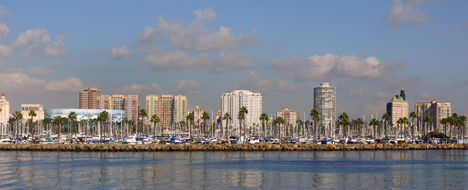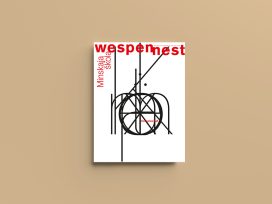The city of Long Beach is a diverse, if not divided, community in the South Bay area of Los Angles County in Southern California. It entered the twentieth century as a seaside resort, but the expansion of the Ports of Long Beach and Los Angeles brought dredging, a surf-killing breakwater and a far greater urban density, as people moved in for work. The constantly running diesel engines of ships and trains still fill the air with a smoke haze not evident in the County’s more glamorous beach cities, further west. Regularly this combines with maritime fog to produce the smog that has disappeared in other parts of the LA basin. By early afternoon this is usually dissipated by “the burn”. But you can’t help wondering what has been left behind in the lungs and the blood of yourself, other people, and the brown pelicans who make vertical dives after fish in the sunset water.

Long Beach California. Photo: Ron Kacmarcik. Source:Shutterstock
In the early 1960s the oil companies – whose black derricks still bob their heads up and down all over Southern California – built artificial islands just offshore, named them after astronauts, and bedecked them with palm trees and simulated cityscapes. The effect was more uncanny than festive. The Pike, a large amusement park which had drawn visitors from all over Southern California, closed for good in the late 1960s.
In February 2013 Long Beach’s waterfront convention centre was obscured for the better part of a week with yards of head-high, white bunting bearing the red logo of TED. It was also screened by the police and security personnel who were there to keep its guests and speakers safe, and uninvited interlopers out. For the three nights of the conference, guests, sometimes still wearing paperback-sized lanyards around their necks, crowded the pavements and night spots of Pine Avenue and Shoreline Drive. Downtown restaurateurs and hoteliers received the usual fleeting uptick in their revenues, then the caravan moved on for good.
But TED’s impending relocation to Vancouver has been the subject of some anxiety in the freebie newspapers and Facebook groups in which Long Beach residents talk to one another. From the 1980s onwards the mechanization of the waterfront, closure of aerospace and military-industrial facilities and general industrial decline had begun to produce the kinds of difficulties that are also familiar to the post-industrial regions of Britain. The departure of jobs and the failure of other equivalent employment to arrive created persistent pockets of severe deprivation in parts of the city. From 2008 inequality increased further, because of the erosion of living-wage employment and the large-scale displacements associated with the global banking crisis. As with other southern parts of the LA conurbation, Long Beach is now in large part a dormitory for low-wage service workers and the many others who are subsisting in even more precarious positions. Gentrification has come to some areas east of downtown that are closer to the water, but to the north and west poverty – of the working and non-working kinds – is immediately visible, and is racially stratified. Abutting Orange County, with all its sprawl and gated wealth, Long Beach faces the sort of identity crisis that tends to view events like TED as a possible deliverance, and their departure as a likely catastrophe.
As Long Beach struggled, TED was on the up. In the five years during which it returned to the city for its annual get-togethers, it entrenched itself as a global brand. This was the period when it began to draw millions more viewers to online videos of its trademark short talks – which promote “ideas worth spreading” – and to franchise out into dozens more localized “TEDx” events around the world. TED has established itself as a signature enterprise of the era following the mass uptake of broadband Internet services and social media platforms. These have lowered the barriers for publishing and consuming information, and, in combination with the political choices made around them, they have also begun to reorder the institutional life of the networked world.
The TED conference started as a one-off in 1984, originated by Richard Wurman, who noticed a convergence of concerns in the fields of “technology, entertainment and design”. The acronym of these fields yielded the conference’s name. Belief in this convergence as not only a mode of technological development but as something with a kind of moral force has since become widespread, and TED has been both a driver and a beneficiary of this faith. From 1990 TED became an annual event, and in 2000 Wurman passed control of the conference to journalist and entrepreneur Chris Anderson. Anderson multiplied the conference into new iterations: TEDActive, a curated “makers” and “hackers” festival that runs in parallel with the main conference; TEDGlobal, which explores “international ideas” in a succession of locations outside the United States; and TEDx, in which the conferences became a truly distributed enterprise. But his most decisive move was in effectively turning TED into a media company.
The growth of the conference into an ideas behemoth came about principally as a result of Anderson’s decision, from 2005, to begin posting videos of selected talks to ted.com. As broadband connectivity made web video more easily accessible, and as services like YouTube not only allowed easy syndication of video, but acculturated people to this form of spectatorship, TED’s videos found larger and larger audiences. This in turn brought about a higher profile for the conference, and a capacity to attract ever more crowd-drawing speakers. (In 2007, TED attracted Bill Clinton; in 2008, Al Gore; in 2013 the headline act was U2’s Bono.) The move to Long Beach came in 2009, as the founding conference venue in Monterey struggled to house all the would-be attendees.
By 2010, Anderson was ready to put TED at the centre of a reconfiguration of the nature of intellectual innovation, which he called “crowd-accelerated innovation”:
And there are just three things you need for this thing to kick into gear. You can think of them as three dials on a giant wheel. You turn up the dials, the wheel starts to turn. And the first thing you need is a crowd, a group of people who share a common interest. The bigger the crowd, the more potential innovators there are […] The second thing you need is light. You need clear, open visibility of what the best people in that crowd are capable of, because that is how you will learn how you will be empowered to participate. And third, you need desire.
In Anderson’s thinking, online video vastly expanded the size of the crowd, heightened the visibility of innovation, and perhaps even stimulated individuals’ desire for achievement. Technology’s wheel has turned the cogs of history, transforming humanity’s collective capacities. As a result, for Anderson, we have been fortunate enough to be able to develop the desirable attributes of the entrepreneur.
TED’s increasing traffic, and pulling power of the conferences, seemed at one level to bear out this view. It certainly gave Anderson the confidence to more aggressively promote this model of intellectual exchange. And this vision, and the TED model, have now fed into proposals for a wholesale configuration of higher education with the use of online video.
Deceptive simplicity
To take TED’s claims at face value would be to accept that online video creates a crowd within which everyone’s creative powers are unleashed, and where all our talents feed into the historically transformative acceleration of entrepreneurial innovation. Certainly, TED’s pitch employs the rhetoric of democratized access to “ideas worth sharing”, but, paradoxically, it also makes ideas an attribute of exceptional celebrities, and depoliticizes knowledge by removing it from the sphere of contention. In other words, TED radically reinscribes an elitist model of intellectual exchange, and a neoliberal-humanist form of social analysis.
We can observe this in the influential aesthetic TED has established for the presentation of ideas online. TED talks all follow a model that the organization has encoded in its rules, so that, despite the diffusion and diversity of TEDx franchises, there is a remarkable consistency of visual style. Unlike the one-camera lecture recordings that are characteristic of higher-education institutions, TED videos are heavily, slickly, produced. Watching them, one is reminded more of the Silicon Valley technology launch or live concert recording than the lecture theatre or conference hall.
Typically, talks are edited into five to ten second cuts, with multiple mobile cameras enhancing visual interest. Speaker footage is regularly intercut with still images, figures, or video from presentation slides, as well as audience reaction shots expressing surprise, delight or joy. As well as longer shots capturing the generally sophisticated production design of venues, we find close-ups emphasising the expressivity of speakers’ faces, and a specific shot that TED has imported from rock concert films: a medium shot of the presenter directly from behind, silhouetted by stage lights, with the massed theatre audience visible in the background. From Scorsese’s Last Waltz onwards, this shot has iconically grounded the authenticity of performance film.
Presentations, then, are bathed in the atmosphere of celebrity and revelation. Along with the time constraints – no TED talk may run longer than 18 minutes – this visual language embeds a set of pedagogical and even epistemological claims. Firstly, despite its democratising rhetoric, TED reinscribes a pedagogy of authoritative instruction. The lecture form, the spectacle of a speaker addressing a rapt crowd, and the gulf in space and time between lecture delivery and online viewings, promote the idea of teaching as a one-way flow of expertise. There’s no room for debate or questions, and no obligation for speakers to address online comments made weeks or months after the talk under their videos. What is absent is any sense that knowledge is constituted in dialogue.
At the same time, TED’s format defines “ideas” as modular, fungible and easily transmitted in convenient formats. Although it doesn’t charge people to watch the videos, TED does radically commodify thought, making ideas interchangeable, and adapted for consumption. Moreover, presenters invariably canvas problems that they have already solved, or at least cracked. TED’s model of thinking is not the critical delineation of problems, or the formulation of better questions, but the closure of “solutionism”. We could describe the common atmosphere in TED talks – and this is perhaps why Bono described himself in his talk as being “sexually excited” by data – as a sort of hegemonic wonkism. They share a common narrative: a problem that has existed in its present form since time immemorial is solved when someone does something counter-intuitive as a result of “out of the box” thinking, or a clever geek takes a new look at the data.
As a generic structure, this enables a political fantasy: that individuals can master and alter complex events without engaging in any serious conflicts over values or resources. But the world, as most adults know, is rarely so responsive to individual will: historically, the biggest changes have come from concerted communal activism and social movements – that is, through some kind of conflict and negotiation. But TED prefers to remain outside agonistic politics:
While TED is happy for speakers to address topics with a political dimension, it candidly tries to minimize the antagonism that animates democratic debate. In the TEDx content guidelines, it warns organizers that TEDx is also not the right platform for talks with an inflammatory political or religious agenda, nor for polarising “us vs them” language. We seek to build consensus, and provide outside-the-box thinking, not to revisit familiar, unresolvable disputes on these matters.
As ever, “consensus” is imagined as the state in which conflict is not just resolved, but transcended. And the royal road which leads to this happy state of affairs is outside-the-box thinking, which, it is proposed, will displace intractable political disagreement. This explicitly depoliticising tendency is reflected elsewhere in the overall TED content guidelines:
Politics and policy are key parts of the global conversation. But the TED and TEDx stages are not the place for partisan politics, nor for extremist or inflammatory positions. Speakers should not advocate for parties, political platforms and political leaders in their talks – nor should they insult or belittle political adversaries. Advise speakers to focus on discussing concrete problems and solutions.
The trouble is that this means that when political leaders and politicians do speak, any sense that their “solutions” may be contentious is passed over. Speakers cannot, should they even wish to, indicate that their proposals arise from a polemic. This then further buttresses the notion that clever ideas can eradicate political antagonism. It erases the fact that the very definition of problems in our common life is itself necessarily political, and that the institutions and mechanisms that administer “solutions” are themselves an artefact of political power.
An illustrative example is a recent talk to TEDx Thessaloniki by Edi Rama, mayor of Tirana, Albania, from 2000 to 2011. The talk’s message was that the project to paint the city’s buildings in bright colours, and the opening of this process up to contemporary artists and designers, had reduced crime and bolstered civic pride, rescuing the city from its post-Communist dereliction – precisely the kind of “outside the box” solutioneering that TED prizes. The suggestion that the social and political fabric of a city can be transformed by the arts of design confirms the power of creativity as outlined in the work of urbanists like Richard Florida. But there is also a promise that capital will be generated, “associated with the aesthetics and tastes that might combat the undesirable and unproductive urban phenomena of squatting, vandalism, graffiti and dereliction”. As much as anything, TED wants to demonstrate the politically transcendent powers of certain kinds of cultural capital, and certain versions of innovation.
Rama only mentions in passing his “demolition of illegal buildings”. But in fact, while he was organizing the painting of buildings, Rama was also incidentally wiping out the informal businesses that had for a long time operated out of kiosks in public parks. So, while some people gained from the release of urban space, the livelihoods of others undoubtedly suffered. Can we believe that this did not involve intense political conflict and principled resistance? Can we believe that there aren’t lasting resentments in the city – which doesn’t yet have reliable drinking water? It may be that Rama’s seizures of property were a laudable disenclosure of public space, but viewers of the video will never know, as Rama is allowed to present his only real opposition as “corruption”. The paucity of alternative accounts available to English speakers means that his talk, presented unchallenged within TEDx guidelines, is allowed to stand as the main record of events. There’s no debate here, and therefore no politics, only a deceptively simple solution – which might actually be just deceptive.
Another example was provided by Bono’s talk to the February 2013 conference. Bono – calling himself a “factivist” – described the erosion of “soul-crushing” poverty in the “developing world”, which he defined as the condition in which people live on less than 1.25 dollars a day. Marshalling data and a rhetoric of “equality”, Bono used animated graphs to describe a trajectory whereby the global proportion of people living in this kind of absolute poverty was shown as declining from 33 per cent in 1990 to 21 per cent in 2013; moreover, his data showed that the trend was moving steadily in the direction of the “erogenous zone” of zero, which it would reach by 2030. He attributed this to “factivism” such as his own, the use of open data (what he called “sunshine”) and new technology, but he also lauded the “lion” economies of sub-Saharan Africa. He argued that these have prospered by, among other things, opening up their economies to foreign investment. Broadly speaking, he urged marginal improvements and state-led charity within a system that preserves the broad outlines of capitalism. He urged the audience to campaign through their representatives for increased aid budgets, and for consumers to pressure oil companies to pay slightly increased royalties to the ostensible owners of resources.
Bono’s discussion of inequality and its remedies was, then, closely bounded. For example he didn’t discuss his native Ireland, where, as in most of the rest of the Western world, poverty has increased on every measure since the crash – and where, as austerity bites, it is largely the poor that suffer the consequences. The data-derived “soul-crushing” threshold cannot accommodate the wide variety of experiences of deprivation across the globe, for income is its sole determinant. This makes poverty distant, African, and answerable to a generalizable statistical measure – not a social relation that plays out differently in different circumstances. Above Bono’s threshold there are millions of people living insecurely across the globe in unequal societies. The effect of the talk was to suggest that global capitalism’s production of inequality contained its own solutions; that wisely moderated through aid, with the impediments to “sunshine” removed, poor nations would eventually become prosperous. Again, there was no capacity for any element of this consensus to be challenged, or even more thoroughly explained. Instead, listeners were encouraged to share an empty optimism.
This is how TED leverages its format, and in this case star power, to create consensus around a liberal humanism, drawing on objects that are distant from the experiences of attendees. What’s ultimately on offer is less ideas than reassurance – primarily the reassurance that our problems are reducible to a series of technical problems or lateral-thinking puzzles, and people like “us” – members of a cosmopolitan liberal elite – have the answers. Like all versions of liberalism, it tries to gentrify politics. One of the results is that it cannot see itself as a symptom of the inequality of the society surrounding it.
A technology and its community
But set against Long Beach, and California more generally, TED can be seen as an embodiment of American economic inequality. In 2013, attendees paid 7,500 dollars apiece for the week of “ideas worth spreading”. It would take someone on California’s minimum wage 937.5 hours to make enough money for the ticket price (and many undocumented migrants work for far less than this). Seven and a half grand is a shade less than the five-year decline in California’s real median family incomes from 2006 to 2011, according to the latest census data (7,726 dollars). However that figure also indicates the further evisceration of the Californian middle class: the top 20 per cent of incomes have actually grown throughout the crisis, and most of the burden of income decline has fallen on the poorest. Long Beach’s unemployment rate is 11.5 per cent, some four per cent higher than the US average, while benefits are miserly and increasingly difficult to obtain.
One block west of the Long Beach Performing Arts Centre, at the very moment Bono was speaking, charity workers were scooping out meals of lentils and rice from a large orange casserole dish. Many of the thirty or so homeless people they were feeding were clearly also suffering from untreated mental illnesses and other health problems that charity simply cannot address. A few blocks in the other direction, a disabled man who said he was a veteran was panhandling as young men milled around the LA metro stop near a discount shopping area. Downtown Long Beach is a poignant reminder that the TED conferences take place in a bubble of liberal-cosmopolitan privilege.
It’s true that you didn’t have to show up to participate. TED was offering individuals and institutions such as primary schools “TED live” online memberships for only 995 dollars. But it’s unlikely that Long Beach public schools will be taking that option – the United School District has suffered cuts that in 2012 alone meant 20 dollars million in budget shortfalls. The City College and CSU Long Beach have had similar problems, as the state slashes public services following revenue crashes during the recession. Until the recent passage of Proposition 30, California’s constitution meant that no new taxes could be raised to address this shortfall.
With the weakening of public institutions – in particular the public university system – organizations like TED, with strong links to Silicon Valley, the entertainment industries and the emerging private education sector, are gaining purchase and prestige as arbiters and brokers of innovation. The veneration of the Valley by the powerful extends to proposals to remake the arts of government in its image. California’s Lieutenant Governor and former San Francisco mayor Gavin Newsom’s recent book, Citizenville: How to Take the Town Square Digital and Reinvent Government, points to the increasing “irrelevance” of government institutions in the face of technological advancement. Newsom advocates the remodelling of democratic participation along the lines of social media, and opening up institutions to data-driven “hacking”, which will lead to counterintuitive solutions to the problems of a “broken” government.
TED offers a model for joining these solutions to failing public infrastructure. A bill was introduced in the California State Senate this year which would have compelled state colleges to award credit for students’ participation in privately provided MOOCs (massively online open courseware), the provision of which is the concern of a burgeoning group of Silicon Valley start-ups. Efforts to expand higher education using the affordances of new technologies continue in the UK in institutions like the Open University. But many MOOC providers simply seek to derive private profit from the induced crises of higher education. The California bill eventually stalled as universities expressed concerns about standards, and promised to provide more online options in their own offerings. But the Valley is increasingly prepared to flex its political muscles, as is evident in the lobbying organization begun by Mark Zuckerberg, fwd.us, which seeks immigration reforms which will make it easier to import workers for tech firms. Mandated MOOCs will offer providers sure profits from a captive market, and technocratic politicians a way of appearing to address the underfunding and huge student debts associated with the state system, without taking the hard decision of providing more public funding. As Aaron Bady recently pointed out, the sudden incorporation of MOOCs into policy discourse represents the end of education as a vector of reform, as well as a “refusal of futurity”, because for the MOOCS promoters, “the future is now, there is nothing
to plan for; the only reality is the economic reality that a funding shortfall must be
dealt with”. This political battle is just beginning.
Fundamentally, TED works to enact a complex inequality. It reinforces the acceptance of a hierarchy of knowledge that fuels Silicon Valley’s prestige by confirming an aristocracy of ideas. This is performed in the curation of events, the production aesthetics of the talks as delivered and recorded, and the high barriers to entry for direct forms of participation. It isolates speakers from disagreement and debate, and attempts to produce consensus around depictions of the social and economic order that render its antagonisms and inequalities amenable to a form of liberal utopianism. And it foreshadows an era where education itself is packaged and sold as a celebritized spectacle to student-consumers at second-tier institutions, while elite universities provide the real thing to their more wealthy counterparts.
In the terms of Jacques Rancière, TED enacts a “distribution of the sensible” that “assigns the privilege of thought to some and the tasks of production to others”. It works to create a political and perceptual field within which the remediation of social ills and conflicts is made the preserve of a cosmopolitan elite whose technocratic consensus precedes its enunciation. As Rancière also remarks, to respond is to enact a dissensus that makes visible what has been excluded from a perceptual field, and makes audible what has been inaudible.
Much of the reaction from those working in higher education to the TED-inflected incursion of MOOCs into the sector has so far been understandably defensive. But it would be more helpful to instead think collectively about how such technologies can truly be harnessed to the purposes of equality. How can we facilitate a disruption of the rapidly solidifying political and aesthetic field that thus distributes the rights to think and speak? How can we grasp at possible moments of transgression? How can we, after TED, manage to commandeer technologies to enact the equality of intelligence?
For places like Long Beach, this question has some urgency. Inequality is becoming its defining quality, and TED has not solved this or any other of Long Beach’s problems: it never could. Unlike earlier kinds of pedagogical institutions, TED is not much concerned with the community that hosts it. It’s an essentially rootless and mobile entertainment product. It is in the cloud, and like the fog that burns off in the afternoon, it’s not clear what, if anything, it has left behind.







